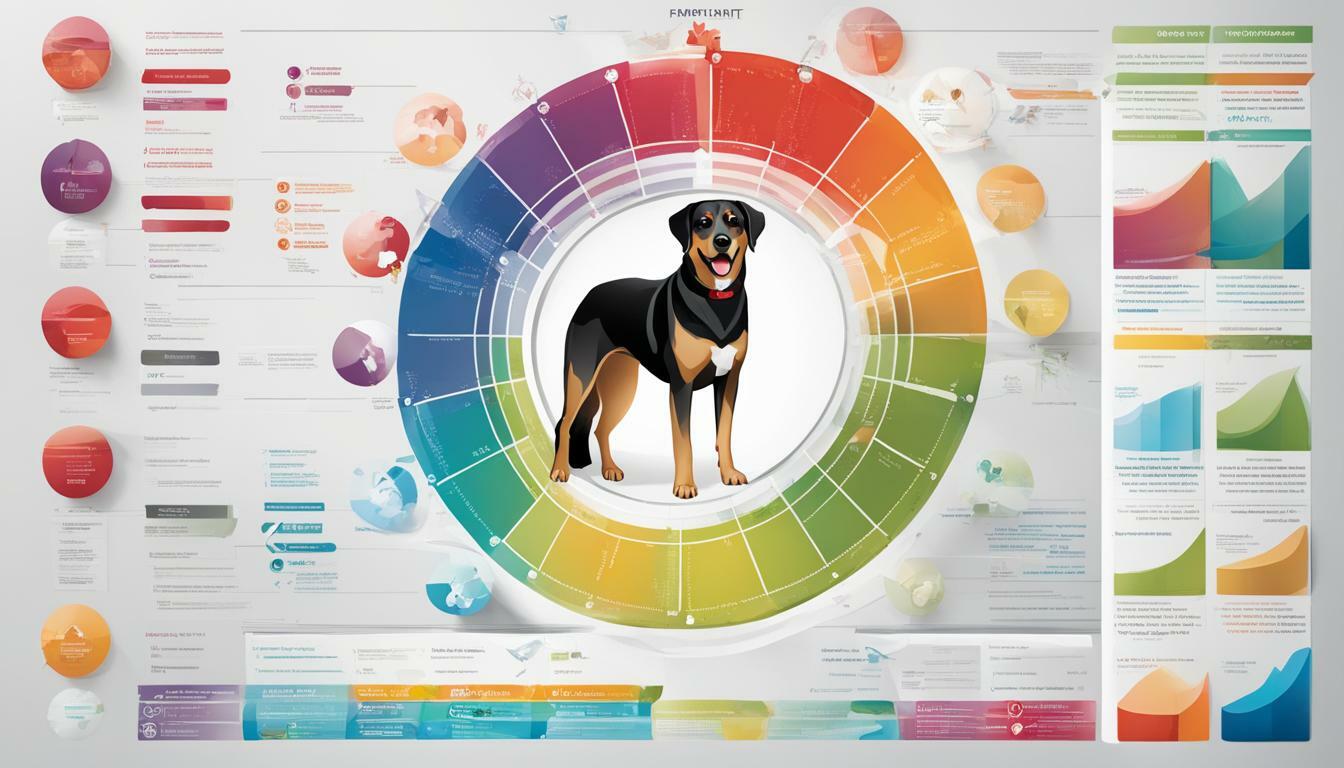If you are a dog owner whose furry friend suffers from allergic dermatitis, you may have encountered the term “Cytopoint Chart” while researching treatment options. Understanding this chart is crucial to ensuring the safe and effective use of Cytopoint, a breakthrough medication for canine allergic dermatitis.
Key Takeaways:
- The Cytopoint Chart is an essential tool for determining the appropriate dosage of Cytopoint for dogs with allergic dermatitis.
- Factors such as the dog’s weight and severity of symptoms may influence the dosing.
- The Cytopoint Chart helps ensure the most effective and appropriate use of Cytopoint in treating canine allergic dermatitis.
If you’re worried about your dog’s itching, we can help you. Follow this link to understand how to Manage Your Dog’s Itching with the Cytopoint Shot.
What is the Cytopoint Chart?
The Cytopoint Chart is a tool used to determine the appropriate dosage of Cytopoint for dogs suffering from allergic dermatitis. This chart considers various factors, including the dog’s weight, severity of symptoms, and response to previous treatments.
While Cytopoint is typically administered by injection, the dosage may differ depending on the dog’s specific needs. The Cytopoint Chart provides precise dosing information based on these individual factors, ensuring the most effective use of the treatment.
The Cytopoint Chart is also designed to be user-friendly, making it easy for pet owners to understand and follow. It typically includes a list of dosing options based on the dog’s weight, corresponding injection amounts, and recommended frequency of administration.
What is Cytopoint Dosing, and How is it Calculated?
Cytopoint dosing is calculated based on the weight of the dog and the severity of its symptoms. The recommended dosage of Cytopoint for dogs is 1mg/kg of body weight, administered subcutaneously. The Cytopoint Chart helps veterinarians determine the dosage amount based on various factors, including the dog’s size, age, and overall health.
The Cytopoint Chart also considers the dog’s response to previous treatments. If a dog has responded well to a lower dose of Cytopoint, for example, the chart may recommend continuing with that dosage rather than increasing it.
Understanding the Cytopoint Injection Chart and Dosage Frequency
The Cytopoint Injection Chart provides the recommended amount based on the dog’s weight. The chart typically includes a range of injection amounts based on weight and information on how frequently the injections should be administered.
For example, a dog weighing 22 and 44 pounds may be recommended an injection of 10mg every four weeks. However, the specific recommended dosage and frequency may vary depending on the dog’s individual needs as determined by the Cytopoint Chart.
Cytopoint Treatment for Canine Allergic Dermatitis
Severe itching, inflammation, and secondary bacterial infections can be caused by atopic dermatitis, a commonly widespread canine allergy. It ultimately leads to an discomforted and stressful life for the dogs. Fortunately, Cytopoint is a relatively innovative option with great promise in relieving dogs suffering from allergic dermatitis.
Cytopoint is an immune protein specifically innovated for fighting allergic dermatitis in dogs. It is administered through injection by a veterinarian, and it works by targeting and neutralizing the specific cytokine, IL-31, that plays a significant role in causing the itching and inflammation associated with this condition.
Cytopoint Administration
Cytopoint is a safe and productive treatment option for dogs with allergic dermatitis. It can only be administered by a licensed veterinarian or their prescription. The injection is typically given subcutaneously, under the skin, every four to eight weeks. Cytopoint injections are only to be administered by a licensed veterinarian, and pet owners should follow their veterinarian’s instructions carefully.
Effectiveness of Cytopoint Treatment
Many studies have supported the Cytopoint and proven it is effective for managing allergies or atopic dermatitis in dogs. In clinical trials, Cytopoint was also shown to be the most effective and better option than all traditional medicines, such as steroids. The efficacy and reduced adverse effects make Cytopoint a popular choice for treating pet owners seeking an affordable yet effective option for their pet’s allergic dermatitis. Many dogs experience relief from itching and inflammation for up to 8 weeks with just a single dosage of injection, reducing the need for frequent vet visits.
Mode of Cytopoint Administration
Cytopoint is administered as an injection by a veterinarian. The syringe filled with Cytopoint is given under the skin and is relatively painless. Your dog’s weight, severity of symptoms, and response to previous treatment decide the frequency of the dosage required. Veterinarians use the Cytopoint Chart to determine the appropriate dosage of Cytopoint for each dog and monitor progress over time.
Understanding Cytopoint Efficacy
Cytopoint is an effective treatment option for canine allergic dermatitis. Numerous clinical trials and studies have demonstrated its efficacy in reducing dog itching and inflammation. One study in the United States evaluated the effects of Cytopoint in 247 dogs with allergic dermatitis. The results showed that a single injection of Cytopoint provided significant relief from itching within 24 hours, and the improvement remained for up to 8 weeks.
Cytopoint functions effectively by targeting and binding to a specific protein in the dog’s body called interleukin-31 (IL-31). This protein creates all those allergic responses associated with allergic dermatitis. This medicine interrupts the itch cycle generated by the IL-31 and hence provides relief to dogs.
Duration and Longevity of Cytopoint
Cytopoint is a long-acting treatment for canine allergic dermatitis. A single injection of this medicine can last for up to eight weeks, and the changes can be seen within 24 hours. Due to this very reason, Cytopoint has emerged as a better option for pet owners who prefer fewer vet visits and avoid the hassle of daily oral medications.
It’s important to note that while Cytopoint provides long-lasting relief from itching and inflammation, it is not a cure for allergic dermatitis. The treatment needs to be continued as per the Cytopoint Chart guidelines to maintain the benefits. Your veterinarian may suggest periodic evaluations to determine your dog’s most appropriate maintenance schedule based on their response to treatment.
Cytopoint is safe and effective for long-term use when administered as per the dosage recommended in the Cytopoint Chart. The treatment has a minimal risk of side effects and provides consistent and reliable relief from allergic symptoms in dogs.
Common Side Effects of Cytopoint
As reported, Cytopoint is a generally safe-to-use medicine proven highly effective. But, in some cases, there are risks associated with this medication as well. The most commonly reported side effects of Cytopoint include:
- Vomiting
- Loose stool or diarrhea
- Lethargy or sleepiness
- Loss of appetite
In rare cases, dogs may experience more serious adverse reactions, such as:
- Swelling in the face, lips, or tongue
- Rapid heartbeat
- Difficulty breathing
- Pale gums
If you notice any of these symptoms in your dog after receiving a Cytopoint injection, seek veterinary attention immediately. These reactions are rare but require prompt treatment to prevent serious complications.
How to Read and Interpret the Cytopoint Chart
The Cytopoint Chart is an essential tool for determining the appropriate dosage of Cytopoint for dogs with allergic dermatitis. Understanding and correctly interpreting the chart is crucial to ensure the optimal benefit of Cytopoint treatment.
The chart is divided into two sections considering the dog’s weight: Dogs weighing 10 and 39.9 pounds fall under the top half section, and dogs weighing 40 and 132 pounds fall under the bottom half. After weighing your dog, you could select the appropriate dosage following the chart.
The chart lists the recommended dosage of Cytopoint for each weight range and severity level. The dosage is represented in milligrams (mg) and is based on the dog’s weight.
When using the Cytopoint Chart, it is essential to follow the guidelines correctly. The dosage should always be at most 20 mg/kg; the maximum dose should be 20 mg/kg every four weeks. It is also essential to consult a veterinarian to determine the appropriate dosing and treatment plan.
In conclusion, the Cytopoint Chart is a valuable tool for pet owners and veterinarians in treating canine allergic dermatitis. Understanding how to read and interpret the chart correctly ensures the safe and effective use of Cytopoint for relieving itchiness and inflammation in dogs.
Drafting a Plan to Discuss Cytopoint Treatment with Your Veterinarian
If you are confused about the potential benefits of the medication for your dog, ask for help from the vet or avoid such medications. Before your appointment, there are some essential steps you can take to ensure a helpful conversation.
- Please write down your dog’s allergy symptoms, when they first appeared, and the frequency of their occurrence.
- Record your dog’s response to previous treatments, including the medications used and any side effects observed.
- Prepare a list of confusions about Cytopoint treatment, including the potential side effects and any interactions with other medications your dog may be taking.
During your appointment, be sure to share this information with your veterinarian. They will use it to assess whether Cytopoint is the right treatment option for your dog and determine the most appropriate dose based on the Cytopoint Chart. Be honest about any reservations or concerns, and do not hesitate to ask your veterinarian to clarify any unclear information.
Cytopoint Chart and Monitoring Progress
Using the Cytopoint Chart to monitor your dog’s progress during treatment is essential in ensuring the most effective use of Cytopoint. The chart provides a clear dosing guide for your veterinarian and helps them determine the appropriate dosage based on your dog’s weight and the severity of their allergic dermatitis.
It’s crucial to schedule periodic evaluations with your veterinarian to determine if the current dosage is still effective or if adjustments are necessary. Evaluations may include a physical examination and allergy testing to assess the dog’s response to treatment.
Cytopoint Chart vs. Other Treatment Options
Several options are available when treating canine allergic dermatitis, including steroids, antihistamines, and immunotherapy. However, the Cytopoint Chart offers some distinct advantages over these other treatments.
Firstly, the Cytopoint Chart provides more targeted and effective relief from itchiness and inflammation in dogs with allergies. Cytopoint targets the proteins that trigger allergic reactions rather than simply masking the symptoms like other medications.
Secondly, using the Cytopoint Chart is more convenient than other treatments, as it only requires a single injection every 4 to 8 weeks, depending on the severity of symptoms. This eliminates the need for daily medication or frequent vet visits.
The Cytopoint Chart provides a sustainable long-term management plan for canine allergic dermatitis. While other treatments may only provide temporary relief, Cytopoint can be used over the long term to manage symptoms and improve the dog’s overall quality of life.
Overall, while other treatment options are available for canine allergic dermatitis, the Cytopoint Chart offers a targeted, convenient, and practical approach to managing symptoms and improving the dog’s overall health and well-being.
Conclusion
In conclusion, the Cytopoint Chart is a valuable tool for treating canine allergic dermatitis in the United States. By providing a precise dosage based on the dog’s weight and severity of symptoms, the chart helps to ensure the most effective and appropriate use of Cytopoint. Cytopoint has been highly influential in soothing itchiness and improving the quality of life for dogs with allergies, with minimal side effects.
- Consult with Your Veterinarian: Essential first step to understanding how Cytopoint can benefit your dog.
- Understand the Cytopoint Chart: Utilize the chart to determine the correct dosage and treatment schedule for your pet.
- Ask Questions: Address any concerns or queries with your vet to clarify how Cytopoint works.
- Regular Evaluations: Periodic check-ups are crucial for assessing your dog’s response to treatment and making necessary adjustments.
- Compare Treatment Options: Understand why Cytopoint may be a superior choice for managing canine allergic dermatitis.
- Appreciate the Convenience: Note Cytopoint’s ease of use and its effectiveness in long-term symptom management.
- Value the Chart as a Tool: Recognize the importance of the Cytopoint Chart in guiding treatment decisions for allergic dermatitis.










